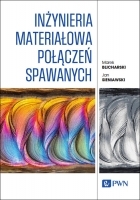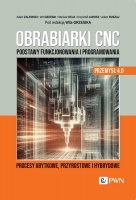Grafen – kierunki rozwoju, zastosowanie
Graphene - directions of development, application
Mechanik nr 12/2015 - Wersje autorskie artykułów ze Szkoły Naukowej Obróbek Erozyjnych 2015 zamieszczone na płycie CD
STRESZCZENIE: Rozwój technologii związany jest z wytwarzaniem nowych materiałów o unikalnych właściwościach. Jednym z najbardziej znanych nowych materiałów, nad którego rozwojem i implementacją pracują ośrodki naukowe i koncerny przemysłowe na całym świecie jest grafen. W artykule przedstawiono kierunki rozwoju w wytwarzaniu grafenu i jego potencjalne zastosowanie.
SŁOWA KLUCZOWE: grafen, technologia wytwarzania, zastosowanie
ABSTRACT: The development of technologies is related with the preparation of new materials with unique properties. One of the most prominent new materials is graphene. This article shows the trends in the production of graphene and its potential application in industry.
KEYWORDS: graphene, production technology, application
BIBLIOGRAFIA / BIBLIOGRAPHY:
- Al-Shurman K. M, Naseem H. A., CVD Graphene Growth Mechanism on Nickel Thin Films, Proceedings of the 2014 COMSOL Conference in Boston, 2014.
- Balandin A.A., Superior Thermal Conductivity of Single-Layer Graphene, Nano Lett., 8 (3), pp 902–907, 2008.
- Boehm H.P., et al. Nomenclature and terminology of graphite intercalation compounds, Pure and Aplied Chemistry,66,1893-1901, 1994.
- Brownson D.A.C et al., Graphene electrochemistry: fundamental concepts through to prominent applications, Chem. Soc. Rev. 41, 6944-6976, 2012.
- Feifei Z. et. al., Hybrid graphene electrodes for supercapacitors of high energy density, Chemical Physics Letters, Volume 584, 2013.
- Garg B., et al. Graphene-Based Nanomaterials as Heterogeneous Acid Catalysts: A Comprehensive Perspective, 19(9), 14582-14614; Molecules 2014.
- Geim A. K., Novoselov K. S, The rise of graphene, Nature Materials, VOL 6, 183 – 191, 2007,
- Hebda M., Łopata A.: Grafen - materiał przyszłości, Czasopismo Techniczne Politechniki Krakowskiej, 22, 45-53, 2012.
- Hernandez Y. et. al., High-yield production of graphene by liquid-phase exfoliation of graphite, Nature Nanotechnology VOL 3, 2008.
- Jianyun Cao et al., High voltage asymmetric supercapacitor based on MnO2 and graphene electrodes, Journal of Electroanalytical Chemistry, Volume 689, 201–206, 2013.
- Landau, L. D. & Lifshitz, E. M. Statistical Physics, Part I (Pergamon, Oxford, 1980).
- Lee C. et al.Measurement of the Elastic Properties and Intrinsic Strength of Monolayer Graphene, Science 18 Vol. 321 no. 5887 pp. 385-388, 2008.
- Liao, L. et al. High-speed graphene transistors with a self-aligned nanowire gate, Nature 467, 305–308 2010.
- Liao, L. et al. Sub-100 nm channel length graphene transistors. Nano Lett. 10, 3952–3956, 2010.
- Liu Jun, et al., Hole and Electron Extraction Layers Based on Graphene Oxide Derivatives for High-Performance Bulk Heterojunction Solar Cells, Advanced Materials, Volume 24, Issue 17, 2228–2233, 2012.
- Moser, J., Barreiro, A. & Bachtold, A. Current-induced cleaning of graphene. Appl. Phys. Lett. 91, 163513 (2007).
- Novoselov K. S. et. al., A roadmap for graphene, 1 9 ,NATURE,VOL 490, 11, 2012.
- Novoselov, K. S. et al. Electric field effect in atomically thin carbon films. Science 306, 666–669 (2004).
- Novoselov, K. S. et al. Two-dimensional atomic crystals. Proc. Natl Acad. Sci. USA 102, 10451–10453 (2005).
- Novoselov, K. S. et al. Two-dimensional gas of massless Dirac fermions in graphene. Nature 438, 197–200 (2005).
- Stańczyk B., Dobrzański L., Jagoda A., Możdżonek M., Natarajan S., Grafen otrzymywany metodą elektrolityczną na podłożach z węglika krzemu, MATERIAŁY ELEKTRONICZNE (Electronic Materials), T. 42, Nr 3/2014.
- Virojanadara, C. et al. Homogeneous large-area graphene layer growth on 6H-SiC(0001). Phys. Rev. B 78, 2008.
- Zhang, Y., Tan, J. W., Stormer, H. L. & Kim, P. Experimental observation of the quantum Hall eff ect and Berry’s phase in graphene. Nature 438, 201–204 (2005).
- Zhibin Yang, et al., Carbon Nanotubes Bridged with Graphene Nanoribbons and Their Use in High-Efficiency Dye-Sensitized Solar Cells, Angewandte Chemie International Edition, Volume 52, Issue 14, 3996–3999, 2013.























